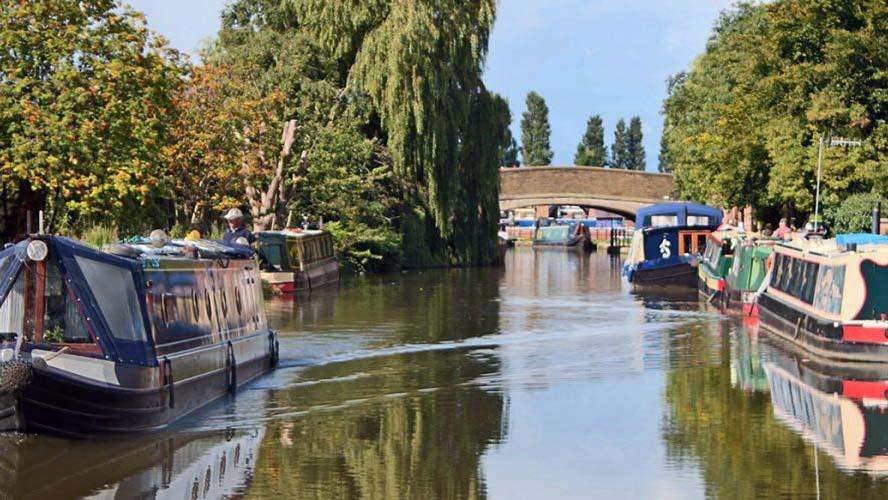Whiskery men gather around a wood-burning stove, strumming guitars and a banjo. Their voices rise in harmony as they sing Ewan MacColl’s classic folk song Dirty Old Town. The lyrics—“By the old canal…”—feel fitting, as we sit beside the historic 127-mile Leeds & Liverpool Canal in Skipton, North Yorkshire.
The Boat House Bar, with its large windows overlooking a canal junction, is a favorite haunt for folk musicians, real ale enthusiasts, and those who simply enjoy watching the waterway’s activity. Every other Sunday, locals come together to play and sing.
Before long, their tunes may include songs about railways too. The long-closed 12-mile Skipton to Colne line, shut down in 1970, has been making headlines, with discussions about reopening it to enhance transport links with East Lancashire. Colne MP Jonathan Hinder supports the project, believing it will provide better access to employment and housing.
For anyone considering a move, Skipton—best known for its building society—offers plenty of appeal. This picturesque gateway to the Yorkshire Dales was recently ranked the sixth happiest place to live in the UK, according to a Rightmove poll. Having spent time here, I can confirm that the locals are a welcoming bunch.
With around 15,000 residents, Skipton maintains a small-town charm where towpath manners—greeting those you pass—extend into its cobbled streets and alleys. An elderly gentleman tipped his hat with a cheerful “Ow do?” while a rosy-cheeked woman responded, “Beautiful day!”
Exploring the town’s compact canal quarter, I found myself in The Beer Engine, a cozy bar where, over a pint of Saltaire bitter, I struck up a conversation with a local named Chris. He spoke enthusiastically about Skipton’s easy access to rivers for kayaking and hills for walking. He also recommended visiting the nearby villages of Appletreewick, Malham, and Grassington—the latter famous as a filming location for All Creatures Great and Small.
That unhurried, neighbourly good life of James Herriot’s days still reigns in Skipton. I witnessed the rare sight of students putting empty sandwich cartons and crisp packets into their rucksacks rather than discarding them onto the towpath as they walked from school in Aireville Park. Next to the school, the leisure centre was busy with people over 60, such as myself, enjoying a swim, followed by a sociable steam and sauna, all for the bargain price of £3.55.
Setting off from the canal junction, where the brightly painted narrowboat Sam, operated by Pennine Cruisers, embarks on 30-minute pleasure trips in all weather, I followed the towpath along the dead-end Springs Branch. Passing beneath the church tower and alongside a converted mill, the path narrowed until it became a precarious strip of land, flanked on one side by a fast-flowing, tannin-tinted beck and on the other by an ivy-covered, disused waterway. Towering above it all were the imposing cliffs and walls of Skipton’s Norman castle.
Originally constructed to transport limestone from quarries in what is now Castle Woods, this branch of the canal has long since fallen out of use. Today, the broadleaf woodland offers several waymarked circular trails. “In spring, it’s carpeted with wild garlic and bluebells,” a dog-walker told me. “What I love about Skipton is how you can step straight from the High Street into these woods and then continue out onto the hills,” she added.
Skipton Castle, one of the most well-preserved medieval fortresses in the UK, remains privately owned and is distinctive for being fully roofed. While one wing serves as the residence of its current owners, the Fattorini family, much of the castle’s history is tied to the Clifford family. Visitors can learn about the remarkable legacy of Lady Anne Clifford, the last of her lineage, who painstakingly restored the castle after it sustained heavy damage during the Civil War.
Not far from the castle, a charming wine shop offers an array of local treasures, including Skipton gin, whose labels depict a boat on the canal, the castle, and sheep—a nod to the town’s name, which is believed to originate from “sheep town.” Housed in a former blacksmith’s, The Wright Wine Company boasts an impressive selection, with over 1,000 different whiskies, a similar number of gins, rare armagnacs priced at £1,000, and an extensive range of wines. “We’ve been coming here for about 40 years,” remarked one customer, warmly greeted by the owner with a kiss on the cheek. The shop’s loyal clientele seems to be its backbone. “People travel an hour and a half just to shop here,” an assistant noted.
When it came to dining, my pub acquaintance Chris had recommended Le Caveau, a High Street restaurant known for its “fancy food.” Set in a former prison—once used to hold felons and sheep rustlers, according to its website—this atmospheric cellar eatery features barrel-vaulted ceilings. However, with a five-course menu priced at £70 (or two courses for £35), it was beyond my budget. Instead, I opted for a hearty bowl of homemade soup and a (generously sized) portion of chips, enjoyed by a roaring fire in the welcoming Woolly Sheep Inn, which also offers rooms for overnight stays.
Shopping is a major draw for visitors to Skipton, with the town’s market running four days a week—Monday, Wednesday, Friday, and Saturday. Lining the High Street, the bustling stalls offer everything from arts and crafts to fresh meat, eggs, cheeses, cakes, handmade clothing, and second-hand books.
The old corn mill I passed earlier, once powered by the tannin-hued waters of Eller Beck, has been transformed into a collection of upscale shops, including one specializing in stylish furniture. Just off the High Street, Craven Court is a charming covered shopping arcade with a glass roof and wrought-iron detailing, developed in the 1980s. While it now houses quaint boutiques and cafés, its origins trace back to a 16th-century theatre, making it a delightful spot for browsing—especially on rainy days.
For those wanting a break from retail therapy, the Craven Museum, housed in the Town Hall, may be small but is rich in history. Exhibits include sheep-shearing and weaving tools, insights into the region’s lead mining past, and information on local geology, from limestone and millstone grit to sandstone, all of which shape the area's distinctive architecture. A historic map of Craven—stretching from Skipton to Settle—suggests the region's name may have Celtic roots, possibly linked to the word for wild garlic. Another display explores the rise of early tourism, highlighting how artists like J.M.W. Turner and Edwin Henry Landseer helped showcase the area’s beauty. As writer J.B. Priestley once declared, “The Dales have never disappointed me. I still consider them the finest countryside in Britain.”
Feeling inspired, I hopped on the 72 bus for a picturesque 30-minute ride to Grassington, disembarking at the final stop—the Visitor Centre for the Yorkshire Dales National Park. From there, I wandered through the village, passing a tea shop humorously advertising “all cakes great and small”, before heading into the hills for a breathtaking circular hike. The route included part of the Dales Way and a scenic high footpath that meandered alongside drystone walls and over stone-stepped stiles.
Patches of drifted snow clung to the shadowed sides of walls, while sheep grazed near bare-branched trees. The landscape stretched endlessly in shades of beige and green, uninterrupted for miles. At one point, I passed an abandoned hilltop farm, Bare House, where wooden shutters rattled in the wind, adding to the remote beauty of the scene.
Returning to the bustling village, I warmed up with a pint of local ale and a satisfying lunch by the wood-burning stove at The Black Horse before catching the bus for the nine-mile journey back to Skipton.
Many towns labeled as “gateways to…” offer little beyond a convenient location and a railway station. Skipton, however, stands apart as one of the most remarkable gateways of them all—and if plans move forward, an additional railway line might soon make getting there even easier.




_2.jpg)



.svg)


